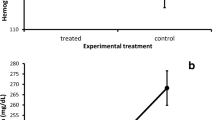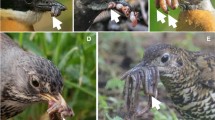Summary
The European starling Sturnus vulgaris preferentially incorporates fresh sprigs of particular plant species for use as nesting material. Chemicals found in these plants may act to reduce pathogen and ectoparasite populations normally found in nest environments. The present experiments were performed to test this Nest Protection Hypothesis. In the fild, we experimentally determined that wild carrot Daucus carota, a plant species preferred as nest material, effectively reduced the number of hematophagous mites found within nests relative to control nests without green vegetation. Chicks from nests containing wild carrot had higher levels of blood hemoglobin than chicks from control nests. However, there were no differences in weight or feather development. In the laboratory, we found that wild carrot and fleabane, Erigeron philadelphicus, (also preferred by starlings as nest material) substantially reduced the emergence of feeding instars of mites, while garlic mustard, Alliaria officinalis, (commonly available but not preferred) had little effect on the emergence of mites. We infer that preferred plant material may act to inhibit feeding or otherwise delay reproduction of mites, thereby reducing risk of anemia to developing nestlings.
Similar content being viewed by others
References
Ambasta SP (1980) No title. Sci Rep 17:210
Arendt WJ (1985a) Philornis ectoparasitism of pearly-eyed thrashers. I. Impact on growth and development of nestlings. Auk 102:270–280
Arendt WJ (1985b) Philornis ectoparasitism of pearly-eyed thrashers. II. Effects on adults and reproduction. Auk 102:281–292
Barclay RMR (1988) Variation in the costs, benefits, and frequency of nest reuse by barn swallows (Hirundo rustica). Auk 105:53–60
Boyd EM (1951) A survey of the parasitism of the Starling Sturnus vulgaris L. in North America. J Parasitol 37:56–84
Brawn JD, Balda RP (1988) Population biology of cavity nesters in northern Arizona: do nest sites limit breeding densities? Condor 90:61–71
Brown CR, Brown MB (1986) Ectoparasitism as a cost of coloniality in cliff swallows (Hirundo pyrrhonota). Ecology 67:1206–1218
Brush T (1983) Cavity use by secondary cavity-nesting birds and response to manipulations. Condor 85:461–466
Clark L, Mason JR (1985) Use of nest material as insecticidal and anti-pathogenic agents by the European Starling. Oecologia (Berlin) 67:169–176
Clark L, Mason JR (1987) Olfactory discrimination of plant volatiles by the European starling. Anim Behav 35:227–235
DeVaney JA (1979) The effects of the northern fowl mite, Ornithonyssus sylviarum, on egg production and body weight of caged white leghorn hens. Poult Sci 58:191–194
DeVaney JA, Quisenberry JH, Doran BH, Bradley JW (1980) Dispersal of the northern fowl mite, Ornithonyssus sylviarum (Canestrini and Fanzago) and the chicken body louse, Menacanthus stramineus (Nitzch), among thirty strains of egg-type hens in a caged laying house. Poult Sci 59:1745–1749
Duffy DC (1983) The ecology of tick parasitism on densely nesting Peruvian seabirds. Ecology 64:110–119
Duke JA (1985) Handbook of medicinal herbs. CRC Press, Boca Raton
Feare CJ (1976) Desertion and abnormal development in a colony of sooty terns Sterna fuscata infested by virus-infected ticks. Ibis 118:112–115
Frear DEH (1948) A catalogue of insecticides and fungicides. VII. Chemical fungicides and plant insecticides. Chronica Botanica Co, Waltham, Mass
Hofstad MS, Barnes HJ, Calnek BW, Reid WM, Yoder HW (1984) Diseases of poultry, 8th edn. Iowa State University Press, Ames, Iowa
Hogstad O (1975) Quantitative relations between hole-nesting and open-nesting species within a passerine breeding community. Norw J Zool 23:261–267
Hoogland JC, Sherman PW (1976) Advantages of Bank Swallow (Riparia riparia) coloniality. Ecol Monogr 46:33–58
Jacobson M (1954) Insecticides from plants: a review of the literature, 1941–1953. USDA Handbook No 154, Washington, DC
Jacobson M (1975) Insecticides from plants: A review of the literature, 1954–1971. USDA Handbook No 461, Washington, DC
Jacobson M, Crosby DG (1971) Naturally occurring insecticides Dekker, New York, Basel
Johnston RF, Hardy JW (1962) Behavior of the Purple Martin. Wilson Bull 74:243–262
Loye JE (1985) The life history and ecology of the cliff swallow bug, Oeciacus vicarius (Hemiptera: Cimicidae). Cah ORSTOM Ser Entomol Med Parasitol 23:133–139
Moss WW, Camin JH (1971) Nest parasitism, productivity and clutch size in purple martins. Science 168:1000–1003
Mustaparta H (1984) Olfaction. In: Bell WJ, Carde RT (eds) Chemical ecology of insects. Chapman and Hall, London, pp 37–64
O'Connor RJ (1984) The growth and development of birds. Wiley, Chichester
Parks CR (1974) Chemical evidence. In: Radford AE, Dickison WC, Massey JR, Bell CR (eds) Vascular plant systematics. Harper and Row, New York, pp 285–305
Powlesland RG (1977) Effects of the haematophagous mite Ornithonyssus bursa on nestling Starlings in New Zealand. NZJ Zool 4:85–94
Powlesland RG (1978) Behavior of the haematophagous mite ornithonyssus bursa in Starling nest boxes in New Zealand. NZJ Zool 5:395–400
Rothschild M, Clay T (1957) Fleas, flukes and cuckoos. Collins, London
SAS Institute Inc (1985) SAS user's guide: statistics, Cary, NC
Sengupta S (1981) Adaptive significance of the use of margosa leaves in nests of the house sparrow Passer domesticus. Emu 81:114–115
Shields WM, Crook JR (1987) Barn swallow coloniality: a net cost for group breeding in the Adirondacks? Ecology 68:1373–1386
Slama K (1979) Insect hormones and antihormones in plants. In: Rosenthal GA, Janzen DH (eds) Herbivores. Their interaction with secondary plant metabolites. Academic Press, New York, pp 683–706
Stadler E (1984) Contact chemoreception. In: Bell WJ, Carde RT (eds) Chemical ecology of insects. Chapman and Hall, London, pp 3–36
Stoner D (1936) Studies on the Bank Swallow Riparia riparia (Linneaus) in the Oneida Lake Region. Roosevelt Wildl Ann 4:126–233
Sykes RK, Chamberlain RW (1954) Laboratory observations on three species of bird mites. J Parasitol 40:491–497
Tenovou R, Lemmetyinen R (1970) On the breeding ecology of the Starling Sturnus vulgaris in the Archipelago of southwestern Finland. Ornis Fenn 47:159–166
Wasylik A (1971) Nest types and abundance of mites. Ekol Pol 19:689–699
Wimberger PH (1984) The use of green plant material in bird nests to avoid ectoparasites. Auk 101:615–618
Winer BJ (1971) Statistical principles in experimental design. McGraw-Hill, New York
Author information
Authors and Affiliations
Rights and permissions
About this article
Cite this article
Clark, L., Russell Mason, J. Effect of biologically active plants used as netst material and the derived benefit to starling nestlings. Oecologia 77, 174–180 (1988). https://doi.org/10.1007/BF00379183
Received:
Issue Date:
DOI: https://doi.org/10.1007/BF00379183




